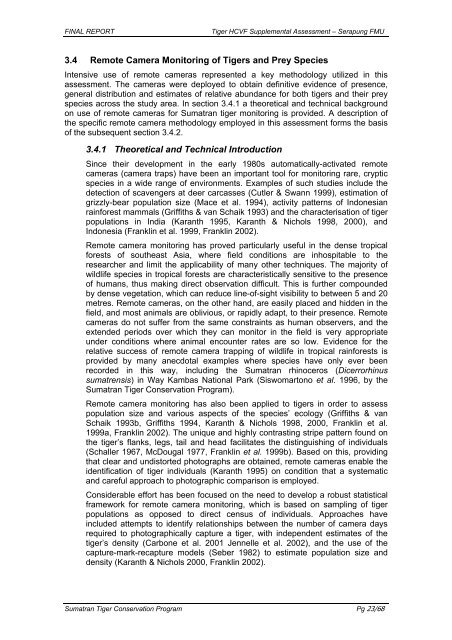A Supplemental HCVF Assessment on the Sumatran Tiger ...
A Supplemental HCVF Assessment on the Sumatran Tiger ...
A Supplemental HCVF Assessment on the Sumatran Tiger ...
You also want an ePaper? Increase the reach of your titles
YUMPU automatically turns print PDFs into web optimized ePapers that Google loves.
FINAL REPORT <strong>Tiger</strong> <str<strong>on</strong>g>HCVF</str<strong>on</strong>g> <str<strong>on</strong>g>Supplemental</str<strong>on</strong>g> <str<strong>on</strong>g>Assessment</str<strong>on</strong>g> – Serapung FMU<br />
3.4 Remote Camera M<strong>on</strong>itoring of <strong>Tiger</strong>s and Prey Species<br />
Intensive use of remote cameras represented a key methodology utilized in this<br />
assessment. The cameras were deployed to obtain definitive evidence of presence,<br />
general distributi<strong>on</strong> and estimates of relative abundance for both tigers and <strong>the</strong>ir prey<br />
species across <strong>the</strong> study area. In secti<strong>on</strong> 3.4.1 a <strong>the</strong>oretical and technical background<br />
<strong>on</strong> use of remote cameras for <strong>Sumatran</strong> tiger m<strong>on</strong>itoring is provided. A descripti<strong>on</strong> of<br />
<strong>the</strong> specific remote camera methodology employed in this assessment forms <strong>the</strong> basis<br />
of <strong>the</strong> subsequent secti<strong>on</strong> 3.4.2.<br />
3.4.1 Theoretical and Technical Introducti<strong>on</strong><br />
Since <strong>the</strong>ir development in <strong>the</strong> early 1980s automatically-activated remote<br />
cameras (camera traps) have been an important tool for m<strong>on</strong>itoring rare, cryptic<br />
species in a wide range of envir<strong>on</strong>ments. Examples of such studies include <strong>the</strong><br />
detecti<strong>on</strong> of scavengers at deer carcasses (Cutler & Swann 1999), estimati<strong>on</strong> of<br />
grizzly-bear populati<strong>on</strong> size (Mace et al. 1994), activity patterns of Ind<strong>on</strong>esian<br />
rainforest mammals (Griffiths & van Schaik 1993) and <strong>the</strong> characterisati<strong>on</strong> of tiger<br />
populati<strong>on</strong>s in India (Karanth 1995, Karanth & Nichols 1998, 2000), and<br />
Ind<strong>on</strong>esia (Franklin et al. 1999, Franklin 2002).<br />
Remote camera m<strong>on</strong>itoring has proved particularly useful in <strong>the</strong> dense tropical<br />
forests of sou<strong>the</strong>ast Asia, where field c<strong>on</strong>diti<strong>on</strong>s are inhospitable to <strong>the</strong><br />
researcher and limit <strong>the</strong> applicability of many o<strong>the</strong>r techniques. The majority of<br />
wildlife species in tropical forests are characteristically sensitive to <strong>the</strong> presence<br />
of humans, thus making direct observati<strong>on</strong> difficult. This is fur<strong>the</strong>r compounded<br />
by dense vegetati<strong>on</strong>, which can reduce line-of-sight visibility to between 5 and 20<br />
metres. Remote cameras, <strong>on</strong> <strong>the</strong> o<strong>the</strong>r hand, are easily placed and hidden in <strong>the</strong><br />
field, and most animals are oblivious, or rapidly adapt, to <strong>the</strong>ir presence. Remote<br />
cameras do not suffer from <strong>the</strong> same c<strong>on</strong>straints as human observers, and <strong>the</strong><br />
extended periods over which <strong>the</strong>y can m<strong>on</strong>itor in <strong>the</strong> field is very appropriate<br />
under c<strong>on</strong>diti<strong>on</strong>s where animal encounter rates are so low. Evidence for <strong>the</strong><br />
relative success of remote camera trapping of wildlife in tropical rainforests is<br />
provided by many anecdotal examples where species have <strong>on</strong>ly ever been<br />
recorded in this way, including <strong>the</strong> <strong>Sumatran</strong> rhinoceros (Dicerrorhinus<br />
sumatrensis) in Way Kambas Nati<strong>on</strong>al Park (Siswomart<strong>on</strong>o et al. 1996, by <strong>the</strong><br />
<strong>Sumatran</strong> <strong>Tiger</strong> C<strong>on</strong>servati<strong>on</strong> Program).<br />
Remote camera m<strong>on</strong>itoring has also been applied to tigers in order to assess<br />
populati<strong>on</strong> size and various aspects of <strong>the</strong> species’ ecology (Griffiths & van<br />
Schaik 1993b, Griffiths 1994, Karanth & Nichols 1998, 2000, Franklin et al.<br />
1999a, Franklin 2002). The unique and highly c<strong>on</strong>trasting stripe pattern found <strong>on</strong><br />
<strong>the</strong> tiger’s flanks, legs, tail and head facilitates <strong>the</strong> distinguishing of individuals<br />
(Schaller 1967, McDougal 1977, Franklin et al. 1999b). Based <strong>on</strong> this, providing<br />
that clear and undistorted photographs are obtained, remote cameras enable <strong>the</strong><br />
identificati<strong>on</strong> of tiger individuals (Karanth 1995) <strong>on</strong> c<strong>on</strong>diti<strong>on</strong> that a systematic<br />
and careful approach to photographic comparis<strong>on</strong> is employed.<br />
C<strong>on</strong>siderable effort has been focused <strong>on</strong> <strong>the</strong> need to develop a robust statistical<br />
framework for remote camera m<strong>on</strong>itoring, which is based <strong>on</strong> sampling of tiger<br />
populati<strong>on</strong>s as opposed to direct census of individuals. Approaches have<br />
included attempts to identify relati<strong>on</strong>ships between <strong>the</strong> number of camera days<br />
required to photographically capture a tiger, with independent estimates of <strong>the</strong><br />
tiger’s density (Carb<strong>on</strong>e et al. 2001 Jennelle et al. 2002), and <strong>the</strong> use of <strong>the</strong><br />
capture-mark-recapture models (Seber 1982) to estimate populati<strong>on</strong> size and<br />
density (Karanth & Nichols 2000, Franklin 2002).<br />
<strong>Sumatran</strong> <strong>Tiger</strong> C<strong>on</strong>servati<strong>on</strong> Program Pg 23/68

















